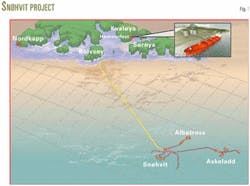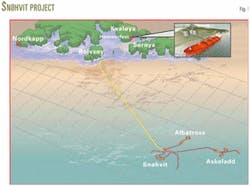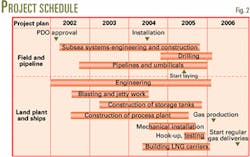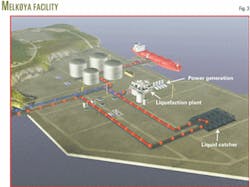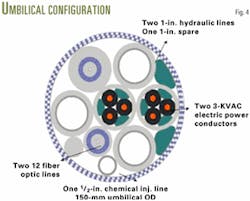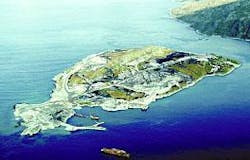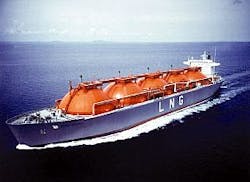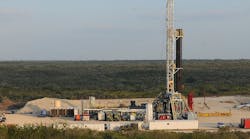Construction has started on the first major project on the Norwegian continental shelf without fixed or floating surface facilities, according to numerous recent announcements by operator Statoil ASA.
The Snøhvit development in the Barents Sea will produce gas from subsea installations, in 250-345 m of water, and transport it through a 160-km multiphase pipeline to a gas-liquefaction plant under construction at Melkøya, an island at the entrance of the shipping channel into Hammerfest, Norway (Fig. 1).
Development plans include drilling 21 wells for producing gas from three fields: Snøhvit, Askeladd, and Albatross. The fields extend across seven production licenses that were unitized in 1999-2000. After unitization the licenses now expire in 2035.
Operator Statoil holds a 22.29% interest the development. Other partners are Petoro AS, 30%; TotalFinaElf Exploration Norge AS, 18.4%; Gaz de France Norge AS, 12%; Norsk Hydro Produksjon AS, 10%; Amerada Hess Norge AS, 3.26%; RWE Dea Norge AS, 2.81%; and Svenska Petroleum Exploration AS, 1.24%.
Snøhvit project
"The Snøhvit project is Statoil's largest and most complex development project," says Statoil's Pres, CEO Olav Fjell.
Statoil estimates the three fields, discovered between 1981 and 1984, contain recoverable reserves of 193 billion cu m of natural gas and 113 million bbl of condensate.
The company expects to produce about 5.75 billion cu m/year of LNG, corresponding to 4.2 million tonnes of gas, along with 747,000 tonnes/year (tpy) of condensate, and 247,000 tpy of LPG.
Long-term contracts for LNG sales involve the sale of 2.4 billion cu m/year to El Paso Global LNG Co. and 1.6 billion cu m/year to Iberdrola SA, a Spanish utility company. The LNG production represents about 70 cargoes/year.
Construction of the processing facilities started in 2002 and Statoil expects first gas deliveries in second half 2006 (Fig. 2).
Statoil estimates a project cost of 40 billion NOK (Norwegian kroner) or $5.3 billion for field development, pipeline, and land plant and 5.8 billion NOK for ships, although it says it continues to study the project's investment framework to determine if identified cost increases will be covered from contingency funding.
Carbon dioxide reinjection
One part of the project involves reinjecting produced CO2 into the 45-75 m thick Tubåsen sandstone at about 2,600 m below the seabed at the Snøhvit field location. A sealing formation above the Tubåsen prevents the CO2 from leaking out of the formation, according to Statoil.
Snøhvit-produced gas contains about 5-8% CO2 and Statoil expects to inject into the Tubåsen sand about 700,000 tpy of CO2.
The Melkøya facility (Fig. 3) will separate the CO2 from the produced gas stream with an amine process at high pressure and moderate temperatures. In the process, amine binds itself to CO2 and separates at the bottom of a tank. This fluid than enters another tank, with a lower pressure and higher temperature, in which the CO2 is released.
Statoil says it also is investigating technologies for removing CO2 from the processing facility flue gases that will be released to the atmosphere.
Pipelines
Statoil plans to control and monitor the subsea production and pipelines from a control room on Melkøya. Plans call for operators to open and close valves on the seabed 140 km away with signals transmitted along fiberoptic cables and with high-voltage electrical and hydraulic power lines.
The project includes a 68 cm ID, 160-km gas pipeline, two chemical lines, an umbilical (Fig. 4), and a CO2 pipeline.
The project schedule indicates that the pipelines will be laid in summer of 2005.
Gas liquefaction
The processing facilities include Statoil's liquefying natural gas technology developed in partnership with Germany's Linde AG.
The facilities liquefy gas containing 90% methane by passing it through a 15 by 17 by 40-m heat exchanger consisting of several externally cooled tubes.
Statoil says the Statoil-Linde technology breaches the monopoly for supplying heat exchangers to the LNG industry previously held by Air Products & Chemicals Inc., Allentown, Pa.
The Statoil-Linde process for liquefying gas at –163° C. requires large amounts of electricity and heat, supplied by a power station integrated in the liquefaction plant and equipped with five LM6000PD turbogenerators fueled by Snøhvit gas. The turbines include a low-nitrogen-oxide burner system. Statoil also says it will have to upgrade the existing power transmission line to Hammerfest to supply 50 Mw in reserve electricity for the gas-liquefaction plant.
Statoil expects to operate the facility for 330 days/year, during which the facility will consume about 1 1.45 Tw-hr/year of electricity. It says this will increase to 1.64 Tw-hr after about 5-7 years.
The facility's heat requirement is 1.25 Tw-hr/year, according to Statoil. The facility will recover heat needed for the liquefaction process from the turbine exhaust channels.
Statoil claims that the gas liquefaction plant will have an energy efficiency of 70%, the best in the world to date.
It says it achieved this efficiency through the use of heat recovery from exhaust fumes and the use of highly efficient gas turbines with the lowest nitrogen oxide emissions for such units.
It estimates that the facility will produce 900,000 tpy of CO2, corresponding to 2% of Norway's total carbon emissions. Of this, it says 674,000 tpy will be reinjected at Snøhvit.
The nitrogen-oxides emissions from the project will be 600-700 tpy, according to Statoil.
Plant construction
The project reduces the needed steelwork at the Melkøya site by barging in the processing plant on a 9 by 154 by 54-m barge, built at the Izar Construcciones Naval's yard in Ferrol, Spain.
The plans call for the 24,000 tonnes of process equipment for the gas-liquefaction plant, installed on the barge, to be transported to Hammerfest and Melkøya on a heavy-lift ship and placed in a dock blasted out the rock (Fig. 5).
LNG carriers
The project will add four LNG carriers to the world fleet that numbers about 130 vessels. Statoil will be part owner of three vessels, all being built in Japan. Each ship can carry about 140,000 cu m of LNG.
Statoil will own one vessel together with Norway's Leif Høegh & Co. and Japan's Mitsui OSK Lines, and two with Japan's Kawasaki Kisen Kaisa, Mitsui & Co Ltd., and Lino Kaiun Kaisa Ltd.
The LNG carriers will have spherical tank design originally developed by Norway's Kvaerner Group in the early 1970s (Fig. 6). Moss Maritime, a unit of Italy's Saipem Group, now owns the design, which Statoil says is used on about 50% of the world's LNG fleet.
TotalFinaElf and Gaz de France will lift their own share of the gas.
